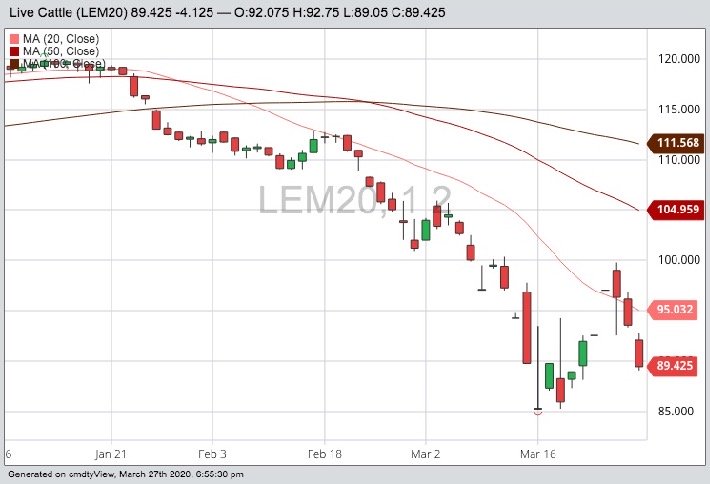Chicago | Reuters — U.S. lean hog futures tumbled on Friday, with several contracts falling the expanded daily limit of 4.5 U.S. cents/lb. on worries about a slowdown in demand for pork and fears that the coronavirus could shutter slaughterhouses, potentially backing up hog supplies, traders said.
Chicago Mercantile Exchange June lean hog futures settled down 4.5 cents at 64.25 cents/lb., a life-of-contract low (all figures US$).
Live cattle and feeder cattle futures also fell sharply. CME June live cattle finished down 4.125 cents at 89.425 cents/lb. while the nearby April contract fell the 4.5-cent limit to 100.95 cents.
Read Also

Alberta crop conditions improve: report
Varied precipitation and warm temperatures were generally beneficial for crop development across Alberta during the week ended July 8, according to the latest provincial crop report released July 11.
CME May feeder cattle futures settled down 4.5 cents at 120.925 cents/lb.
Limits for hogs and live cattle will remain at 4.5 cents for Monday’s trade and feeder cattle limits will widen to 6.75 cents, the exchange said.
A worker at a Smithfield Foods plant at Sioux Falls, S.D. tested positive for the coronavirus, the Argus Leader newspaper reported on Thursday, raising fears among traders of possible shutdowns. Smithfield officials could not be reached for comment.
“That news that a Smithfield plant employee tested positive for the virus has people scared that we are going to have to shut a plant down and lose capacity,” said Brian Hoops, president of Midwest Market Solutions.
Separately, the Canadian Food Inspection Agency did shut production at Harmony Beef, a southern Alberta packing plant, due to concerns about the spread of COVID-19, an industry group said Friday.
Still, some traders said concerns about bottlenecks of hogs and cattle were overblown.
“That was a great fear in the market a couple of weeks ago, but now we are dealing with it and it is really not causing the backup in hog numbers or cattle numbers,” said Dennis Smith, commodity broker for Archer Financial Services in Chicago.
“The profit margins are so fantastic (that) these packers have every incentive in the world to figure this out,” he said.
Hog futures faced additional pressure after the U.S. Department of Agriculture late Thursday reported the U.S. hog herd as of March 1 at 77.6 million head, up four per cent from a year ago but roughly in line with trade expectations.
Also bearish were softening wholesale meat prices, a possible sign that consumers are scaling back panic-buying at the supermarket after stocking their freezers with meat.
The U.S. pork cutout fell by $3.82 on Friday afternoon, its fourth straight daily decline, according to USDA data.
— Julie Ingwersen is a Reuters commodities correspondent in Chicago.














